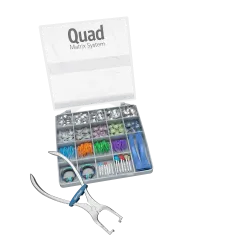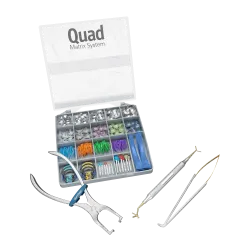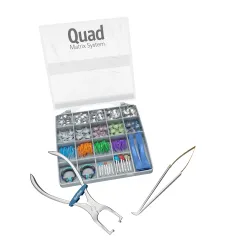Restoring Class II proximal surfaces can be one of the most technically challenging tasks in dentistry. Dentists often face difficulties working on adjacent or quadrant restorations, especially when trying to achieve proper anatomical contours and ideal contact points. The process can be time-consuming, requiring precision and attention to detail, with results that are not always predictable. Some common postoperative complications include food impaction, gingival inflammation, sensitivity, and secondary complications caries.
Proper techniques, such as using sectional matrices, can help alleviate some of these complications. However, traditional systems often fall short in challenging cases. Some do not provide the necessary stability and contouring to create tight, accurate contact points, while others can be unwieldy or impractical when handling multiple restorations in a quadrant. These limitations can result in frustration, inefficiencies, and suboptimal clinical outcomes.
To address many of these challenges in Class II direct restorations, Garrison® Dental Solutions has introduced the Quad Matrix System™, an innovative solution designed to create precise contours and dependable contact points in both standard and back-to-back restorations. The system includes two groundbreaking products that transform Class II restorations: split wedges and asymmetrical rings. Both components are crafted to integrate seamlessly, enhancing workflow, saving time, and improving quality. Quad split wedges, available in four sizes (small, medium, large, and anatomical for irregular anatomies), adapt easily to various clinical scenarios. Their split design reinforces the gingival seal and prevents upward displacement by the papilla, ensuring stability throughout the procedure. The Quad wedge should be inserted from either the buccal or palatal/lingual side, with the split end positioned to emerge on the side with the widest embrasure. To complement and maximize the benefits of the Quad split wedge, Garrison has developed specific asymmetrical rings. These Quad rings work in tandem with the split wedges, effectively securing the matrix band, minimizing excess material, and promoting excellent contact points. One side of the ring features a driver tip designed to collaborate with Quad split wedges, ensuring a firm gingival margin seal, while the opposite side incorporates a traditional contouring pad to adapt to the natural tooth anatomy. These rings are available in short and tall sizes for both right and left quadrants.
This clinical case report illustrates the replacement of a deficient Class II composite restoration in the maxillary right first quadrant using the Quad Matrix System, highlighting the benefits previously discussed.











